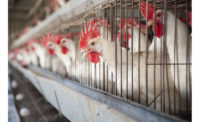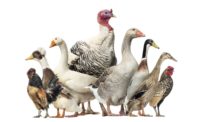Katina Beniaris, Editorial Intern
One of the worst animal-disease epidemics in U.S. history hit nationwide last year. In December 2014, the USDA’s Animal and Plant Health Inspection Service (APHIS) confirmed the highly pathogenic avian influenza (HPAI) detected in 21 states, with more than 200 commercial and backyard poultry premises affected.
For the baking industry, the outbreak quickly brought havoc for egg production. The USDA reported more than 42 million egg-layer and pullet chickens were depopulated. An egg shortage occurred with suppliers using imports and bakers turning to egg replacers. While food safety measures have been applied to farms across the country, it does not mean the outbreak has been forgotten.
“Avian influenza still remains as a concern for anyone in the egg industry,” says Jonathan Spurway, vice president of marketing and optimization at Rembrandt Foods, Rembrandt, IA. “There are multiple strains from all over the world, and it’s a common flu at the end of the day.”
Improving biosecurity
Various cases of avian influenza occur all over the world, but the USDA now plans to be more prepared. The agency stated in a January 2016 report, “To prepare for additional outbreaks that could occur in 2016 or later, our planning activities assumed a worst-case scenario beginning in September 2015, with HPAI occurring simultaneously in multiple sectors of the poultry industry throughout the nation.”
The last known avian influenza outbreak in the United States occurred last January. And with the recent safety measures, it was not as nearly as bad as previous hits. According to the USDA, an outbreak of HPAI (H7N8), which is a different strain to last year’s outbreak, was reported in Dubois County, IN and detected in eight nearby turkey flocks. USDA responded quickly, avoiding any other outbreaks to spread outside of the controlled area.
In July, another avian influenza outbreak was reported in Ontario (see “Avian influenza confirmed on farm in St. Catharines, Ontario”). This was a low-pathogenic strain and occurred on a duck farm. All of the birds were euthanized.
In the meantime, farms across the United States are making changes to protect themselves from any future outbreaks. The third-largest egg producer, Rembrandt Foods, lost more than 50 percent of its vertically integrated supply across two of its major production sites during the outbreak period, according to the company.
“We increased our biosecurity. We put up a plan in place that increased our biosecurity from where it was. We still believe that we have one of the world’s leading biosecurity systems,” Spurway says. “However, as we’ve discovered, even being the world leader, that doesn’t ensure preventing avian influenza.”
There are four main vectors of health concern for Rembrandt Foods: food, water, air and physical contact. With some of their farms being located in Iowa, it was part of the worst state to be hit with the outbreak period along with other Midwest states such as Wisconsin and Nebraska.
Even when some egg producers were not greatly affected by the avian influenza, they still are improving their food safety measures. “Today our biosecurity program was a lot more robust than it was,” says Jasen Urena, director of sales and marketing, Specialty Egg Division, NestFresh Eggs, Denver. The company improved its program even though it was not impacted by the last outbreak.
According to USDA APHIS, biosecurity is key to keeping poultry healthy. Recommendations include taking steps to prevent the spread of the virus, such as cleaning vehicles and cages, knowing the warning signs of bird diseases and reporting sick birds. (USDA APHIS maintains a comprehensive “Avian Influenza Disease” page, featuring news, updates and preventative measures egg producers can take to prevent and control outbreaks.)
Ongoing recovery
The 2015 avian influenza outbreak led to significant egg shortages and skyrocketed prices across the country. However, one year later, production levels have picked up.
“We went from a very short supply situation as an industry, and now we’re in a larger supply situation,” Urena explains. “We have eggs to cover the demand that was left over after avian influenza in the United States. So that’s what was really driving prices down.”
According to the latest USDA “Chicken and Eggs” report, U.S. egg production totaled 8.58 billion during August 2016, up 10 percent compared to last year.
Production levels are increasing, and egg prices are low. Maro Ibarburu, associate scientist at the Egg Industry Center, Iowa State University, Ames, says prices are at the “lowest since 2006.” Prices are so low that some egg producers, especially for small businesses, are dealing with profitability issues.
Ibarburu adds, “We are predicting a higher flock by the end of the year… but it will depend what the prices are and how much supply we are going to have.”
Opting for replacers
For the baking industry, the avian influenza outbreak and egg shortages greatly affected the supply chain. One common solution turned to using ingredients with partial or complete egg replacement.
Suppliers of egg replacers had to act very quickly when the avian flu crisis hit in spring 2015, notes Jean Bacardi, regional market segment lead, bakery and beverage at ICL Food Specialties Inc., St. Louis. “The companies that already had ingredient systems on the market were in the best position to meet the urgent needs of the market,” she says.
Jon Stratford, sales and marketing manager, Natural Products, Inc., Grinnell, IA, says they had a very busy second half of 2015 with new applications for products they historically had not worked on.
“One example is cheesecake, which we had not done any work until a cheesecake manufacturer called and let us know that they could not get any more eggs,” Stratford says. “We went to work in our lab to figure out which of our ingredients might help them eliminate the eggs, and that project resulted in a new customer.”
Egg replacers vary from company to company. Some examples of egg alternatives include whey proteins, citrus pulp, guar gum, algal flour, whole-food fiber and much more. Many bakers who switched to egg replacements last year are continuing to use the ingredients for multiple reasons.
“Industrial bakers and formulators are looking at some of the very functional egg-replacement products available to meet ‘free from’ claims, reduce sources of allergens in bakeries and processing plants, and often just to improve texture and stability,” says Bacardi, “whether the product already contains eggs or not.”
An opportunity to raise awareness of egg replacers occurred from the outbreak period—and helped suppliers be better prepared if avian influenza resurfaces to a level that could impact egg product supply. Now egg-replacement suppliers have had the opportunity to get the word out about the benefits of the ingredients and how they can best work in formulas for baked goods.
“It is important for anyone considering reformulating an existing product to have reduced eggs that ‘egg replacement’ be viewed as a process, not as an ingredient,” Stratford says. “The food maker will need to commit to a series of trials and take a methodical approach to rebuilding the qualities in the product.”
The benefits of real eggs
Historically, eggs have seen widespread use in many types of baked goods—and many bakers have a preference for the natural and multifunctional benefits of real egg products. “Egg replacers and egg extenders don’t perform the same way as fresh eggs,” says Urena.
A recent study by CuliNex, Seattle, compared the performance of egg replacers to real eggs. The tests included baking products ranging from a cheesecake to yellow batter cake.
Mark Crowell, principal culinologist, CuliNex, explains: “Results show that without eggs, baked goods made with egg replacers can be overly pale, muted in flavor, and weak in structure. Conversely, they can also be overly dark or excessively yellow, have strong off flavors and aromas, and be tough or dense.”
Some egg replacers are blends of highly functional ingredients, which can result in complex ingredient statements on products. Usage rates differ depending on the ingredient system in question. With the egg replacers used by CuliNex, no single replacer was able to replicate eggs at the manufacturer's usage level.
Crowell adds: “Egg ingredients serve to provide beneficial qualities in baked goods, especially cakes. Liquid egg products contain moisture that hydrates the dry ingredients and starts reacting with chemical leaveners. One of the most-important qualities egg ingredients contribute is batter emulsification, which comes from the natural lecithin in egg yolk, an extremely effective emulsifier.”
Egg producers continue to increase their food safety measures to avoid any future outbreaks, and supply is stable for now. But the avian influenza aftermath has left bakers many with new options should an egg shortage crisis arise again in the future.
For additional coverage and information, click here.






